Brussels, located in the heart of Europe, stands as a beacon of international diplomacy, a melting pot of cultures, and a city steeped in rich history. Yet, the allure of Brussels extends far beyond its famed chocolate shops, the Atomium’s gleaming spheres, and the intricate Gothic architecture of the Grand Place. Just a short journey from the city’s bustling streets lies a treasure trove of experiences, each offering a unique glimpse into the beauty, history, and culture of Belgium and its neighbors. This blog post embarks on a journey to uncover the best day trips from Brussels, inviting adventurers and culture enthusiasts alike to explore the enchanting destinations that lie just a stone’s throw away.
Each destination we’ll explore offers a distinct flavor, a different story, and a unique experience that enriches our understanding of this region’s diverse tapestry. From the cobblestone streets of Bruges, whispering tales of merchant wealth and maritime power, to the solemn battlefields of Waterloo, where Europe’s fate was once decided, the variety of day trips from Brussels showcases the multifaceted character of Belgium and its surrounding areas.
First on our list is the historic heart of Bruges, a city that seems suspended in time, its medieval architecture perfectly preserved, reflecting in the still waters of its canals. Then, we tread the hallowed ground of Waterloo, where history enthusiasts can immerse themselves in one of the most pivotal battles of the 19th century. Antwerp beckons with its artistic legacy, home to the works of Rubens and a vibrant contemporary art scene, while Ghent offers a blend of past and present, its ancient buildings now housing lively bars and cultural venues.
Not all treasures lie in the past, as the Caves of Han-sur-Lesse and the majestic Ardennes demonstrate with their breathtaking natural beauty. The fairytale castle of Gaasbeek and the charming village of Durbuy invite visitors into a storybook setting, while the cultural riches of Mechelen and the university city of Leuven offer a deep dive into Belgium’s rich heritage and intellectual history.
The Historic Heart of Bruges
Embarking on a journey from the cosmopolitan streets of Brussels to the timeless allure of Bruges is like stepping through the pages of a medieval fairy tale. Located in the heart of Flanders, Bruges, or Brugge as it is known in Dutch, is a testament to the splendor of medieval Europe, preserved with such care that one might feel time has stood still. This city, with its winding canals, cobblestone streets, and breathtaking architecture, invites visitors to explore the historic heart of Belgium.
The Enchanting Atmosphere of Bruges
Upon arrival, Bruges immediately wraps visitors in its enchanting atmosphere. The air carries the melody of church bells, the aroma of fresh waffles, and a sense of serenity rare in the bustling modern world. The city’s well-preserved medieval architecture, including houses, market squares, and public buildings, paint a vivid picture of its prosperous past. As a prominent trading center in the Middle Ages, Bruges amassed wealth and cultural richness, the evidence of which stands proudly to this day.
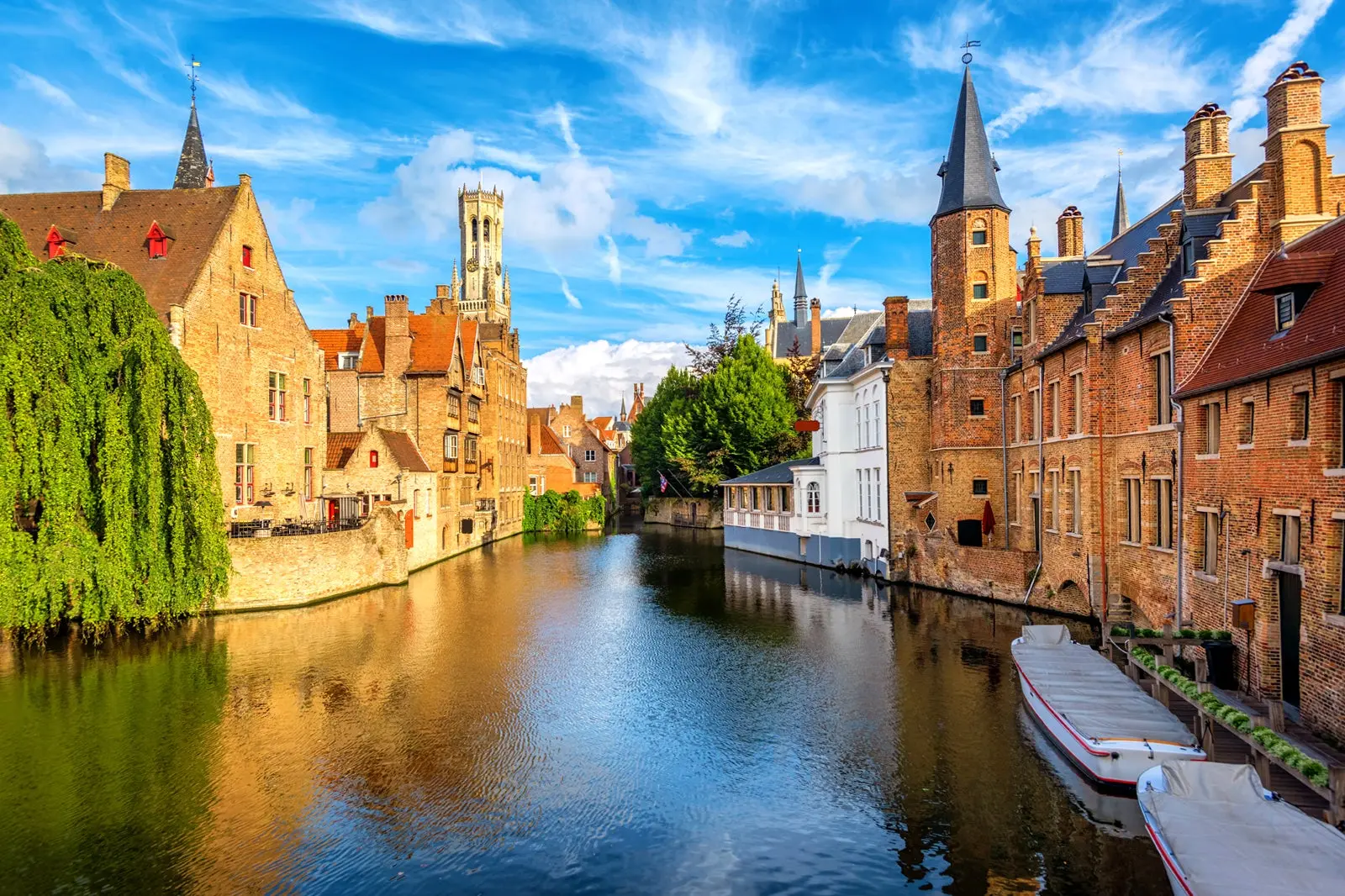
Source: Hotels
The Belfry of Bruges
Dominating the skyline, the Belfry of Bruges is an iconic symbol of the city’s independence and historical significance. Climbing its 366 steps rewards adventurers with a panoramic view of Bruges and its surroundings, a vista of red-tiled roofs, and winding canals. The carillon, consisting of 47 melodious bells, adds a musical backdrop to the city, enchanting visitors and locals alike.
Canals of Bruges
The canals of Bruges, often referred to as the city’s arteries, are essential to its charm. A boat tour offers a unique perspective on the city, passing under ancient bridges and alongside picturesque buildings whose reflections dance on the water’s surface. These waterways, once vital for trade, now serve as pathways to explore the hidden gems of Bruges.
Groeningemuseum
Art enthusiasts will find a haven in the Groeningemuseum, which houses a comprehensive collection of Flemish and Belgian paintings. Works by Jan van Eyck and Hans Memling, among others, showcase the city’s rich artistic heritage. The museum provides a journey through six centuries of art, highlighting the mastery of Flemish Primitives and the vibrant works of modern artists.
Minnewater Lake
Known as the Lake of Love, Minnewater is a tranquil oasis within the city. Legend has it that the lake and its surrounding park are a place of romance and reflection, embodying the soul of Bruges. A stroll around Minnewater offers a peaceful retreat from the city’s lively streets, with graceful swans gliding over the water adding to its charm.
The Battlefields of Waterloo
The Battle of Waterloo, a pivotal moment in European history, resonates through the ages, marking the end of Napoleon Bonaparte’s rule and the beginning of a period of peace in Europe that lasted for decades. Just a short journey from Brussels, the battlefields of Waterloo offer a profound and immersive experience, allowing visitors to step back in time to June 18, 1815, when the fate of Europe was decided in a single day of fierce combat. This article delves into the historical significance of Waterloo and guides visitors through the essential sights and activities that bring this monumental event to life.
The Historical Significance of Waterloo
Waterloo stands as a testament to the complexities of war and the shifting alliances that defined early 19th-century Europe. The battle saw British, Dutch, Belgian, and Prussian forces, under the command of the Duke of Wellington and Field Marshal Gebhard Leberecht von Blücher, clash with the French army led by Napoleon. This confrontation was the culmination of the Napoleonic Wars, marking a definitive end to Napoleon’s ambitions of European domination and leading to his abdication and exile.
The significance of Waterloo extends beyond the battlefield; it heralded the Congress of Vienna’s reshaping of the European political landscape, promoting a balance of power that aimed to prevent future conflicts of such scale. The battle’s legacy is one of international cooperation against a common threat, a concept that has influenced diplomatic relations to this day.
The Lion’s Mound
The most iconic landmark of the Waterloo battlefields is the Lion’s Mound, a monumental artificial hill crowned with a cast iron lion statue. This monument, built to commemorate the spot where the Prince of Orange was wounded, offers panoramic views of the battlefield. A climb to the top rewards visitors with a better understanding of the battle’s scale and the strategic positions of the opposing armies.
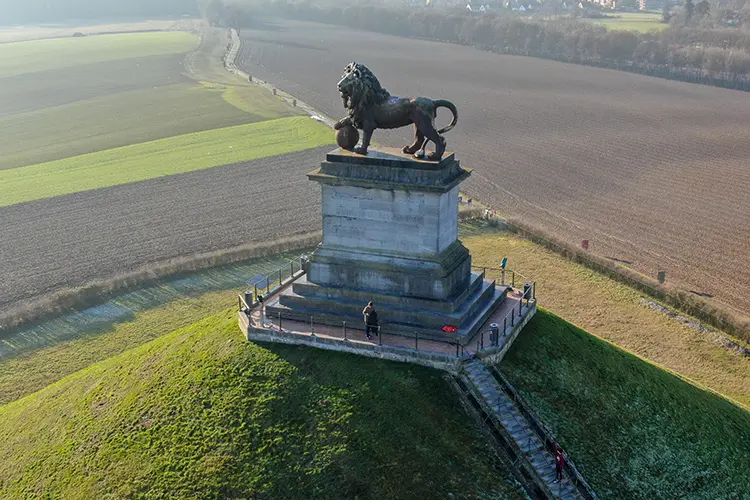
Source: History Hit
Wellington Museum
Housed in the inn that served as Wellington’s headquarters, the Wellington Museum provides insight into the life and strategy of the British commander. The museum’s collection includes personal belongings, maps, and uniforms, offering a glimpse into the planning and execution of the battle. The preserved quarters and exhibits paint a vivid picture of the moments leading up to the clash.
Hougoumont Farm
A key site in the Battle of Waterloo, Hougoumont Farm was the scene of intense fighting. Today, it stands as a symbol of bravery and strategic defense, having held out against French attacks throughout the battle. The farm’s restored buildings and interactive exhibits tell the story of its defenders and the pivotal role the site played in the battle’s outcome.
Memorial 1815 and the Visitor Centre
The Memorial 1815 and its adjacent Visitor Centre offer an immersive experience, with multimedia presentations and artifacts that delve into the battle’s history. The panoramic painting, which depicts the heat of the battle, and the 4D film experience bring the intensity and emotion of Waterloo to life, providing visitors with a profound understanding of the conflict’s impact.
Reenactments and Living History Events
These gatherings bring together enthusiasts from around the world, dressed in period uniforms and employing tactics used in the battle. Observing or participating in these events offers a unique opportunity to experience the sights and sounds of 19th-century warfare, adding a dynamic layer to the historical exploration of the site.
The Artistic Legacy of Antwerp
Antwerp, a city synonymous with diamonds, fashion, and above all, a remarkable artistic heritage, stands proudly on the banks of the Scheldt River. This Flemish metropolis has long been a crucible of creativity, nurturing talents that have left an indelible mark on the world of art. From the baroque brilliance of Peter Paul Rubens to the avant-garde vision of contemporary artists, Antwerp’s contribution to art history is both profound and pervasive. This exploration into the city’s artistic legacy will guide you through the cobblestone streets of Antwerp, revealing the major sights and museums where the city’s heart and soul continue to resonate through centuries of masterpieces.
Antwerp’s Place in Art History
The story of Antwerp and its artistic prominence begins in the 16th century, during a period known as the Golden Age of Flemish Art. This era witnessed the emergence of artists who would redefine the boundaries of painting, sculpture, and printmaking. Among them, Peter Paul Rubens stands as a colossus, his works embodying the exuberance and grandeur of the Baroque movement. However, Antwerp’s art scene was not confined to the past; it has continually evolved, embracing and influencing successive art movements, from the Flemish Primitives to the contemporary.
Antwerp’s role as a major trading port contributed significantly to its artistic flourishing. The wealth that flowed into the city from trade and commerce provided patronage for artists and fostered an environment where creativity could thrive. The Royal Academy of Fine Arts, founded in 1663, further cemented Antwerp’s status as a center of artistic training and innovation, attracting students from across Europe.

Source: National Geographic
The Rubens House
The Rubens House (Rubenshuis) is not merely a museum; it is a journey into the life and mind of Peter Paul Rubens. Located in the heart of Antwerp, this palatial residence and studio, designed by Rubens himself, houses a significant collection of his works. The masterpieces displayed here, including self-portraits and mythological scenes, offer a glimpse into the artist’s world, showcasing his mastery over color, light, and emotion. The Rubens House also provides insight into the artist’s role as a diplomat and collector, making it a key site for understanding the man behind the canvases.
The Royal Museum of Fine Arts
Currently undergoing renovations and slated for reopening, the Royal Museum of Fine Arts (Koninklijk Museum voor Schone Kunsten Antwerpen) houses a treasure trove of Flemish art. Its extensive collection spans several centuries, featuring works by Rubens, Van Dyck, Jordaens, and many other masters. The museum’s vast galleries offer a chronological journey through the evolution of art in Antwerp and beyond, highlighting the city’s enduring influence on the European art scene.
The Museum Plantin-Moretus
The Museum Plantin-Moretus is a UNESCO World Heritage site that offers a unique perspective on Antwerp’s artistic heritage. This museum, housed in the former residence and printing workshop of the Plantin and Moretus families, celebrates the city’s pivotal role in the history of printing. The beautifully preserved printing presses, an extensive collection of typographical material, and the library, containing rare manuscripts and early printed books, illustrate the intersection of art and technology that fueled the spread of Renaissance ideas.
The Cathedral of Our Lady
The Cathedral of Our Lady (Onze-Lieve-Vrouwekathedraal) stands as a monument to Gothic architecture and houses an impressive collection of art, including several works by Rubens. The cathedral’s towering spire, one of the city’s most recognizable landmarks, guides visitors to this sanctuary of faith and beauty. Inside, the artworks serve as a testament to the deep connection between religious devotion and artistic expression that characterizes much of Antwerp’s art history.
Ghent: A Blend of Past and Present
Ghent, a vibrant city where waterways intersect amidst a tableau of historical grandeur and contemporary zest, stands as a testament to Belgium’s ability to harmonize the past with the present.
Ghent’s Historical Architecture
The city’s architecture is a chronicle of its rich history, with edifices that narrate tales from medieval prosperity to contemporary innovation. The Gravensteen, a castle that dates back to the Middle Ages, stands as a formidable reminder of Ghent’s medieval might. Once the residence of counts, today it offers breathtaking views of the city from its ramparts and a glimpse into the past with its museum of medieval life.
The belfry of Ghent, a UNESCO World Heritage site, pierces the skyline, symbolizing the city’s independence. Its carillon sings a melody that has echoed through centuries, marking the passage of time. Nearby, St. Bavo’s Cathedral shelters the famed Adoration of the Mystic Lamb, a masterpiece by the brothers Van Eyck that continues to draw admirers from around the world.
Equally striking is the city’s array of guild houses, with their stepped gables and ornate facades, lining the Graslei and Korenlei along the Lys River. These buildings, once the heart of Ghent’s commercial might, now serve as picturesque backdrops to the city’s vibrant life.

Source: Audley Travel
Contemporary Culture in Ghent
Ghent’s pulse beats strongest in its contemporary culture, which permeates through its historical framework, creating a dynamic tapestry of old and new. The city is a canvas for street artists, with murals that transform ordinary walls into expressions of creative vigor. The Werregarenstraat, also known as Graffiti Street, encapsulates this spirit, offering a constantly evolving gallery of urban art.
Cultural festivals breathe life into the city throughout the year, with the Ghent Festivities being the crown jewel. This ten-day extravaganza of music, theatre, and dance transforms the city into a vibrant tableau of creativity and celebration, showcasing local talent alongside international acts.
The contemporary art scene finds a home in the S.M.A.K., the Museum of Contemporary Art, where exhibitions challenge perceptions and provoke thought. Here, the works of Belgian and international artists spark conversations about the issues of our time, bridging the gap between Ghent’s historical roots and its future aspirations.
Can’t-Miss Experiences in Ghent
To experience Ghent from its waterways offers a unique perspective on the city. The canals, once vital trade routes, now serve as serene paths through its heart, flanked by architectural marvels and greenery. A guided boat tour not only provides insights into Ghent’s history but also reveals hidden gems not visible from the streets.
The Patershol district, with its cobbled lanes and historic charm, is the epicurean center of Ghent. This area is a gastronomic delight, offering everything from traditional Flemish cuisine to international dishes. The intimacy of the district, with its small, cozy restaurants, makes dining here an experience that intertwines culinary excellence with the warmth of Ghent’s hospitality.
A climb to the top of Ghent’s belfry not only offers panoramic views of the city but also a journey through history. The ascent reveals the inner workings of the carillon and the history of the city’s watchful guardianship over its citizens. At the summit, the expanse of Ghent unfolds, a mosaic of history and modernity, green spaces, and urban vibrancy.
Ghent’s Light Plan transforms the city into a nocturnal wonderland, with strategic lighting that accentuates its architectural beauty and creates a magical atmosphere. A walk through Ghent at night, following the light trail, is a mesmerizing experience, showcasing the city’s landmarks in a new, ethereal light.
For art enthusiasts, Ghent offers a plethora of galleries and workshops. The city’s support for artists means that there’s always something new to discover, from avant-garde exhibitions at the S.M.A.K. to independent galleries showcasing emerging talent. The blend of historical inspiration and contemporary creativity makes Ghent a fertile ground for artistic exploration.
The Caves of Han-sur-Lesse
Tucked away in the serene landscape of the Belgian Ardennes, the Caves of Han-sur-Lesse offer an extraordinary journey into the heart of the earth. This natural wonder, formed millions of years ago, is a testament to the power and beauty of nature’s artistry. As we venture beneath the surface, the caves unveil an underworld of stalactites and stalagmites, echoing chambers, and hidden rivers. Beyond the caves, the village of Han-sur-Lesse serves as a gateway to a variety of activities set against the backdrop of the Ardennes’ lush forests and rolling hills. This exploration into the Caves of Han-sur-Lesse and its surroundings reveals a world where adventure and tranquility coexist.
Activities in and Around Han-sur-Lesse
Beyond the caves, Han-sur-Lesse and its surroundings beckon with activities that celebrate the beauty and bounty of the Ardennes.
Adjacent to the caves, the Domain of the Caves of Han hosts a wildlife park that spans over 250 hectares of natural scenery, offering visitors the chance to encounter the European Big Five: the wolf, bear, bison, lynx, and wolverine, along with other wildlife native to the region. Safari tours, either on foot or by safari car, provide insights into the animals’ habitats and conservation efforts, blending adventure with environmental awareness.
The Ardennes is a haven for outdoor enthusiasts, and Han-sur-Lesse serves as an ideal starting point for exploring its vast network of hiking and biking trails. The landscapes around the village offer varied terrains, from gentle walks along the Lesse River to challenging hikes up the surrounding hills, each trail offering its own unique vistas and opportunities for encountering wildlife.
The river, winding its way through the Ardennes, reveals secluded spots, dramatic rock formations, and tranquil stretches, making for an exhilarating yet peaceful journey through nature.

Source: Our World Heritage
Local Gastronomy
Exploring the natural and cultural heritage of Han-sur-Lesse also means indulging in the local gastronomy. The village and its surroundings are home to a variety of dining options, from cozy cafés serving traditional Belgian waffles and beer to restaurants offering gourmet dishes made with local ingredients. The region’s cheeses, charcuterie, and craft beers are not to be missed, providing a taste of the Ardennes’ culinary richness.
Cultural and Historical Sites
While the natural wonders of Han-sur-Lesse draw visitors from afar, the area is also rich in cultural and historical sites. The nearby Château de Lavaux-Sainte-Anne presents a glimpse into the region’s history, with its well-preserved architecture and museum collections. Local markets and festivals, celebrating everything from traditional music to artisanal crafts, offer a chance to immerse in the local culture and community.
The Fairytale Castle of Gaasbeek
Located within the lush landscapes of the Pajottenland, just a stone’s throw from Brussels, lies Gaasbeek Castle, a monument that seems to have sprung from the pages of a fairytale. This castle, with its storied past and breathtaking grounds, invites visitors into a world where history, art, and nature converge. The story of Gaasbeek Castle is one of intrigue, transformation, and preservation, offering a glimpse into the life of nobility, the evolution of architectural styles, and the enduring allure of the romantic past.
The Grounds
The castle is surrounded by expansive grounds, offering a harmonious blend of landscaped gardens, dense woodlands, and tranquil ponds. The park, designed in the English landscape style, invites leisurely walks and exploration, with surprises around every corner—from hidden grottoes to art installations that reflect the castle’s ongoing engagement with contemporary artists.
One of the highlights of the grounds is the Baroque garden, meticulously restored to its original 17th-century design, complete with geometric flower beds and ornamental statues. The garden serves as a living museum of horticulture and design, offering a peaceful retreat and a window into the past’s gardening fashions.
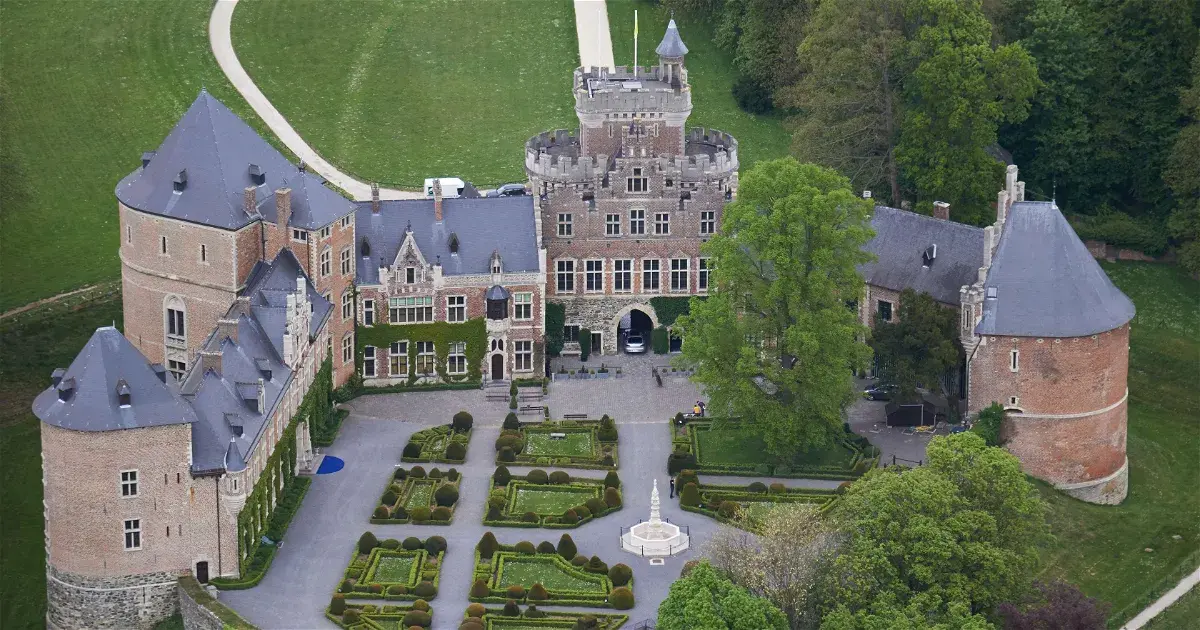
Source: WhichMuseum
Leuven: A University City with Centuries of History
Leuven, a city where ancient cobblestones meet the vibrant pulse of academic life, stands as a beacon of knowledge and history in the heart of Belgium. Home to the oldest Catholic university in the world, founded in 1425, Leuven is a city that has nurtured scholars, artists, and thinkers for centuries. This unique blend of youthful energy and historical depth makes Leuven an intriguing destination, offering visitors a rich tapestry of cultural, architectural, and intellectual treasures.
The University Library and Tower
A symbol of resilience and renewal, the University Library is a must-visit landmark in Leuven. Its grand façade and richly decorated interiors house millions of volumes and an extensive collection of manuscripts and rare books. The library’s tower offers panoramic views of the city, providing a literal and metaphorical overview of Leuven’s academic and urban landscape.
The Old Market Square
Known as the longest bar in the world, the Old Market Square (Oude Markt) is the social heart of Leuven. Lined with cafes and bars, this bustling square is where students, locals, and visitors come together to enjoy a drink, share stories, and revel in the city’s lively atmosphere. The square’s historic buildings, each with its own story, add a backdrop of architectural beauty to the convivial scene.
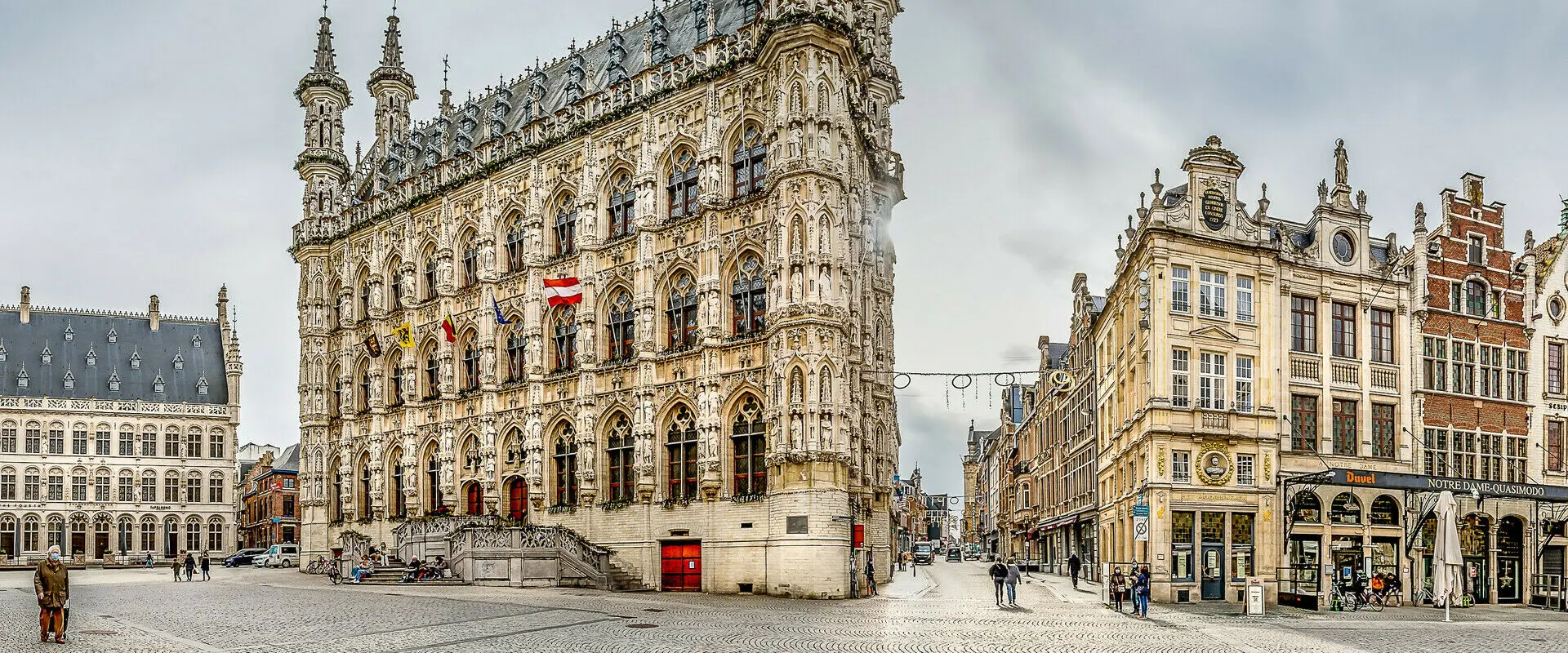
Source: Study
The Great Beguinage
A UNESCO World Heritage site, the Great Beguinage (Groot Begijnhof) is a remarkable example of a complete medieval community. This network of streets, squares, gardens, and houses was once home to Beguines, lay religious women who lived in community without taking vows. Today, it serves as a peaceful retreat from the city’s bustle, with its beautifully preserved buildings housing university students and staff.
St. Peter’s Church and the Treasury
St. Peter’s Church, standing majestically on Leuven’s Grote Markt, is a masterpiece of Brabantine Gothic architecture. Inside, the church’s treasury holds an exquisite collection of religious art, including the renowned Last Supper by Dirk Bouts, a gem of Flemish Primitive painting. The church and its treasures offer a glimpse into the spiritual and artistic life of Leuven through the ages.
Botanical Garden
The Botanical Garden, or Kruidtuin, is the oldest botanical garden in Belgium. Created by the university in the early 18th century for medicinal research, today it serves as a lush oasis of plant life in the city center. With its greenhouses, herb gardens, and thematic plant collections, the Botanical Garden is a place of beauty and learning, reflecting Leuven’s enduring commitment to knowledge and nature.
Innovation and Research Hubs
Leuven’s status as a university city is underscored by its cutting-edge research and innovation hubs. Visitors interested in science and technology can explore institutions like imec, a world-leading research center in nanoelectronics and digital technologies. These hubs not only contribute to global progress but also offer a window into the future being shaped in Leuven.
The Majestic Ardennes
The Ardennes, a region of vast forests, rolling hills, and meandering rivers, stretches across southeastern Belgium and into Luxembourg and France, presenting a tapestry of natural beauty that captivates the heart of every nature lover and adventure enthusiast. Known for its dense woodlands, rugged terrain, and picturesque villages, the Ardennes offers a retreat into the tranquility of nature, where the hustle of city life gives way to the gentle sounds of the forest and the clear, flowing waters of its rivers. This exploration of the Ardennes will uncover the natural wonders of the region and highlight the myriad outdoor adventures that await within its enchanting landscapes.
Outdoor Adventures in the Ardennes
The Ardennes is a playground for outdoor adventure, offering activities that cater to all levels of enthusiasm and expertise. From leisurely walks through the forests to challenging hikes across rugged terrain, the region’s network of trails invites exploration of its natural wonders at every turn.
With an extensive network of marked trails, the Ardennes is a paradise for hikers and cyclists. Trails such as the Transardennaise and the GR 57 offer routes that traverse the heart of the region, providing breathtaking views and encounters with the area’s diverse flora and fauna. Mountain biking enthusiasts will find plenty of challenging routes, with steep climbs and exhilarating descents through the forested landscapes.
The rivers of the Ardennes, with their varying flows and scenic backdrops, offer fantastic opportunities for kayaking and canoeing. The Semois River, with its meandering course and serene beauty, is perfect for a leisurely paddle, while the Ourthe and Meuse rivers provide more challenging stretches for experienced kayakers, offering a unique perspective on the region’s natural beauty.
The crags at Freyr, Sy, and Dave offer not only challenging climbs but also stunning views over the river valleys. The region’s limestone geology has also created a fascinating underground world of caves, such as the Caves of Han-sur-Lesse and the Cave of Remouchamps, where guided tours reveal the beauty of stalactites, stalagmites, and subterranean rivers.
The diverse ecosystems of the Ardennes are a haven for wildlife, making it an ideal spot for wildlife watching and nature photography. The forests and reserves, such as the Parc Naturel des Hautes Fagnes-Eifel, provide opportunities to observe animals in their natural habitat and capture the beauty of the Ardennes’ landscapes and biodiversity through the lens.
The rivers and lakes of the Ardennes are renowned for their clean waters and abundant fish, attracting anglers seeking tranquility and the thrill of the catch. The region’s forests and reserves also offer controlled hunting opportunities, with sustainable practices that ensure the conservation of wildlife populations.

Source: Break en Ardennes
The Charming Village of Durbuy
Durbuy, often hailed as the “smallest town in the world,” is a jewel located in the heart of the Belgian Ardennes. This medieval town, with its cobbled streets, quaint buildings, and picturesque setting along the River Ourthe, captivates visitors with its charm and history. Despite its modern growth and the development of surrounding areas, Durbuy has retained the title as a testament to its unique character and heritage.
Why Durbuy is Known as the Smallest Town in the World
The title of “the smallest town in the world” dates back to a charter granted by John I, Count of Luxembourg and King of Bohemia, in 1331, which accorded Durbuy the status of a town despite its small size. This historical accolade has been proudly maintained over the centuries as a part of Durbuy’s identity, attracting visitors curious to experience the charm of this miniature town. Today, Durbuy’s reputation as the smallest town is more a reflection of its quaint atmosphere and medieval charm than a literal measure of its size, especially considering the expansion and development it has undergone.
The Old Town
The heart of Durbuy’s allure lies in its old town, a labyrinth of narrow lanes lined with ancient stone houses, some dating back to the 17th century. Walking through the old town feels like stepping back in time, with every corner and alleyway telling a story of centuries past. The Grand Rue, with its shops, restaurants, and cafes, offers a delightful mix of local craftsmanship and culinary delights, inviting visitors to savor the town’s atmosphere.

Source: Ardennes Etape
Durbuy Castle
Overlooking the town, Durbuy Castle is a private estate that adds to the town’s medieval charm. While the castle itself is not open to the public, its presence is felt throughout Durbuy, with views of its imposing structure visible from various points in the town. The castle’s history, dating back to the 11th century, and its picturesque setting on a rocky bluff above the Ourthe River, make it a focal point of Durbuy’s landscape.
Topiary Park
The Topiary Park, boasting the largest collection of boxwood sculptures in the world, is a testament to Durbuy’s charm and whimsy. Here, visitors can wander among more than 250 meticulously crafted figures, ranging from animals to mythical creatures, all set against the backdrop of the town and its castle. The park offers a unique blend of art, nature, and creativity, reflecting the town’s spirit.
Durbuy’s surrounding landscapes of the Ardennes provide a playground for adventure seekers. The town serves as a base for outdoor activities, including kayaking on the Ourthe River, mountain biking through the forests, and rock climbing on the nearby cliffs. Adventure parks in the area offer zip-lining, spelunking, and obstacle courses, catering to families, groups, and individuals looking for an adrenaline rush in a natural setting.
No visit to Durbuy is complete without indulging in the local cuisine. The town is renowned for its gastronomic offerings, with restaurants serving dishes that blend traditional Belgian flavors with modern culinary techniques. Local specialties include game, truffles, and the famous Ardennes ham, all of which can be enjoyed in the cozy ambiance of Durbuy’s eateries.
The Cultural Riches of Mechelen
Mechelen, a city situated in the heart of Flanders, Belgium, is a treasure trove of cultural and historical riches. With its roots stretching back to the Roman era, Mechelen has played a pivotal role in the history of the Low Countries. As a former capital of the Burgundian Netherlands, the city boasts an impressive array of architectural marvels, art, and an engaging cultural scene that caters to all ages. Mechelen’s charm lies not only in its historical significance but also in its ability to offer a family-friendly environment, making it an ideal destination for exploring with children. Let’s delve into the historical and cultural sites of Mechelen and discover how this city can be a delightful exploration ground for families.
St. Rumbold’s Cathedral
Dominating the city’s skyline, St. Rumbold’s Cathedral is a masterpiece of Gothic architecture. Its tower, a UNESCO World Heritage site, offers panoramic views of Mechelen and beyond, rewarding those who climb its steps. Inside, the cathedral houses an array of artistic treasures, including works by Flemish masters and the celebrated Carillon school, where the art of bell ringing is still taught and practiced, echoing the city’s rich musical heritage.
Mechelen was at the heart of Burgundian and Habsburg power in the Low Countries, and the city’s palaces reflect this illustrious past. The Court of Margaret of Austria, now the City Hall, was a center of Renaissance culture and politics.

Source: EuroParcs
Museum Hof van Busleyden
This Renaissance palace turned museum offers an immersive journey into Mechelen’s Golden Age. The Museum Hof van Busleyden boasts an impressive collection that showcases the city’s role as a hub of humanism, art, and craftsmanship. The museum’s interactive displays and family-friendly approach make it an enriching experience for visitors of all ages.
Mechelen Toy Museum
A paradise for the young and young-at-heart, the Mechelen Toy Museum (Speelgoedmuseum) houses an extensive collection of toys from various eras and countries. Through interactive exhibits and play areas, the museum not only entertains but also educates about the cultural and historical contexts of toys, making it a perfect stop for families.
Exploring Mechelen with Children
Boat Trips on the Dyle River
A boat trip along the Dyle offers a unique perspective of Mechelen’s historical center from the water. These guided tours are both informative and relaxing, providing a scenic route through the city’s heart, much to the delight of children and adults alike.
Planckendael Zoo
Just outside Mechelen, the Planckendael Zoo is an adventure of its own. Home to a wide range of animals from every continent, the zoo focuses on conservation and education. With its spacious enclosures, playgrounds, and interactive exhibits, Planckendael offers a fun-filled day out for families, connecting them with nature and wildlife.
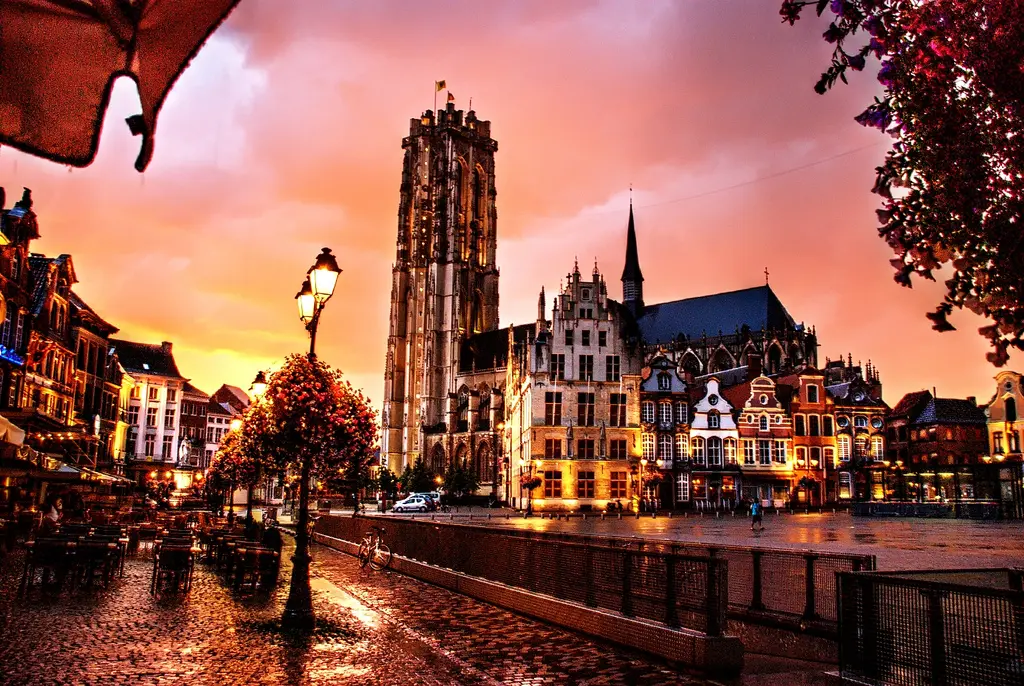
Source: EUObserver
Technopolis
Technopolis, the Flemish Science Centre, is where curiosity meets discovery. This interactive science museum makes learning fun and accessible through hands-on exhibits, workshops, and demonstrations that cover various aspects of science and technology. It’s an ideal place for sparking children’s interest in the mysteries of the world around them.
Conclusion
The exploration of best day trips from Brussels reveals a tapestry of experiences that capture the essence of Belgium and its neighboring regions. From the cobbled streets of Bruges, echoing with tales of medieval trade and splendor, to the solemn history etched into the Battlefields of Waterloo, these destinations offer a journey through time and culture. Antwerp’s artistic legacy, showcasing the brilliance of Rubens and the contemporary vibrancy of its fashion scene, contrasts with the tranquil beauty of the Ardennes, a haven for nature lovers and adventurers alike.
Mechelen presents a blend of historical richness and family-friendly activities, ensuring that visitors of all ages find something to marvel at. The smallest town in the world, Durbuy, offers charm and adventure in equal measure, located within the verdant landscapes of the Ardennes. Ghent captivates with its blend of historical architecture and contemporary culture, providing a vibrant backdrop for exploration. The fairytale allure of Gaasbeek Castle and its surrounding parkland invites visitors to step into a storybook setting, while Leuven’s university heritage and intellectual vibrancy offer a glimpse into the city’s dynamic spirit.
Each destination, with its unique attractions and experiences, underscores the diversity and richness of the regions surrounding Brussels. The call to adventure beyond Brussels is a call to immerse oneself in the varied tapestry of landscapes, history, and culture that define this part of Europe. It’s an invitation to wander ancient streets, to marvel at artistic and architectural masterpieces, to commune with nature, and to indulge in the rich culinary traditions of the region. Each day trips from Brussels is not just a journey through space, but a journey through time, offering insights into the past that have shaped the present.
In conclusion, the areas surrounding Brussels serve as a reminder of the enduring allure of exploration and adventure. They beckon with the promise of discovery, inviting travelers to experience the diversity and richness of life beyond the city’s limits.


